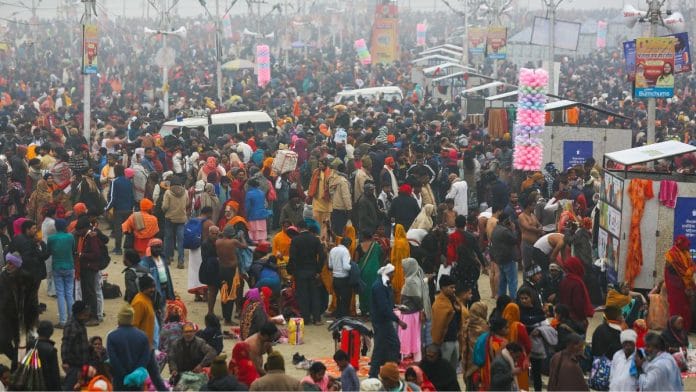Thank you dear subscribers, we are overwhelmed with your response.
Your Turn is a unique section from ThePrint featuring points of view from its subscribers. If you are a subscriber, have a point of view, please send it to us. If not, do subscribe here: https://theprint.in/
India’s recent experiences with large public gatherings, particularly at the New Delhi railway station and the Prayagraj Mahakumbh, underscore a pressing need for enhanced crowd management training and techniques. As the country continues to host major events that attract millions, the challenges associated with crowd control become increasingly evident. The tragic incidents of overcrowding and stampedes highlight the critical importance of implementing effective crowd management strategies to ensure public safety. The New Delhi railway station, one of the busiest transit points in India, often experiences overwhelming crowds, especially during festivals and holidays. In recent years, there have been instances where poor crowd management has led to chaos, resulting in injuries and even fatalities. Similarly, the Prayagraj Mahakumbh, a religious gathering that draws millions of pilgrims every twelve years, has faced significant challenges in managing the vast influx of attendees. These events not only pose logistical challenges but also present serious risks to public safety if not managed effectively.
To address these issues, India must adopt a structured approach to crowd management that encompasses training for personnel involved in event organization and security. Effective crowd management begins with proactive planning and thorough risk assessments. Event organizers should identify potential hazards and develop comprehensive plans that address various scenarios. This includes understanding crowd dynamics and employing strategies such as real-time monitoring to detect issues like overcrowding or potential panic situations before they escalate.
A key component of successful crowd management is staff training. Personnel must be equipped with skills to recognize signs of distress among attendees and respond appropriately. Training should cover both preventative measures and emergency response protocols. For instance, staff should be trained in de-escalation techniques and conflict resolution to manage tensions before they lead to chaos. Moreover, strategic positioning of trained personnel at entry points, high-traffic areas, and exits can help maintain order and assist attendees as needed. Clear communication is another vital aspect of effective crowd management. Providing attendees with clear instructions through signage and announcements can significantly reduce confusion during large gatherings. Information about entry points, exits, emergency procedures, and prohibited behaviors should be readily accessible to all participants. Utilizing technology such as crowd management apps can enhance communication efforts by providing real-time updates and alerts to attendees. The integration of modern technology into crowd management strategies can also play a crucial role in improving safety at mass gatherings. Tools such as CCTV cameras for monitoring crowd behavior and mobile applications for real-time updates can facilitate better decision-making during events. Additionally, employing data analytics to predict crowd flow patterns can help organizers optimize resource allocation and improve overall safety measures.
Moreover, post-event evaluations are essential for refining crowd management strategies. Conducting thorough debriefings allows organizers to assess what worked well and identify areas for improvement. This iterative process is crucial for enhancing future event safety protocols and ensuring that lessons learned are applied in subsequent gatherings. The need for crowd management techniques goes beyond physical barriers and law enforcement. Effective crowd control requires a combination of technology, communication, and human psychology. For example, the use of real-time surveillance, mobile apps for crowd density tracking, and AI-powered predictive analytics can help authorities anticipate and mitigate bottlenecks before they escalate. In Japan and Singapore, similar systems have successfully controlled festival crowds and India’s urban centers could benefit immensely from adopting such innovations.A significant gap, however, lies in the training of ground-level personnel — railway staff, police, and volunteers — who are the first responders in crises. The National Disaster Management Authority (NDMA) has recognized the need for a more structured approach to crowd management in India. Their guidelines emphasize the importance of transitioning from a reactive “crowd control” mindset to a proactive “crowd management” strategy that integrates disaster management principles. This comprehensive approach involves collaboration among various stakeholders, including local authorities, event organizers, and security personnel.
In conclusion, India’s growing population and increasing frequency of large-scale events necessitate a robust framework for effective crowd management. The recent experiences at the New Delhi railway station and Prayagraj Mahakumbh serve as stark reminders of the potential dangers posed by inadequate crowd control measures. By investing in training programs for personnel, leveraging technology for real-time monitoring, ensuring clear communication with attendees, and conducting thorough post-event evaluations, India can significantly enhance its ability to manage crowds safely and efficiently. The implementation of these strategies will not only protect public safety but also foster a more positive experience for all participants in future events.
These pieces are being published as they have been received – they have not been edited/fact-checked by ThePrint.


